Use este identificador para citar ou linkar para este item:
http://www.alice.cnptia.embrapa.br/alice/handle/doc/475998Registro completo de metadados
| Campo DC | Valor | Idioma |
|---|---|---|
| dc.contributor.author | VIANA, P. A. | pt_BR |
| dc.contributor.author | GUIMARAES, P. E. O. | pt_BR |
| dc.date.accessioned | 2011-04-10T11:11:11Z | pt_BR |
| dc.date.accessioned | 2011-04-10T11:11:11Z | pt_BR |
| dc.date.available | 2011-04-10T11:11:11Z | pt_BR |
| dc.date.available | 2011-04-10T11:11:11Z | pt_BR |
| dc.date.created | 1997-08-27 | pt_BR |
| dc.date.issued | 1997 | pt_BR |
| dc.identifier.citation | In: INTERNATIONAL SYMPOSIUM ON INSECT RESISTANT MAIZE: recent advances and utilization, 1994, Mexico. Proceedings.. Mexico: CIMMYT, 1997. p. 112-116 | pt_BR |
| dc.identifier.uri | http://www.alice.cnptia.embrapa.br/alice/handle/doc/475998 | pt_BR |
| dc.description | Maize, Zea mays, is an important cereal crop in Brazil, It is extensively grown throughout the country for food grain, feed, and fodder purposes. Among many factors, insects pests play a major role in limiting maize yields. The lesser cornstalk borer (LCB) and the fall armyworm (FAW) have been considered the most important field pests, being key pests in many of the areas where the crop is grown. The FAW and the LCB have been reared at EMBRAPA/CNPMS to undertake artificaial infestation for large-scale studies, including screeening for resistance. Several genetic materials were selected for resistance. Sources of resistance such as CMS 23 and cms 24 to FAW, CMS 15 and CMS 454 to LCB are being used in breeding for resistance. The resistance mechanisms to FAWwere studied on four selected maize genotypes. Larvae reared on CMS 14C required longer to develop to the pupal and adult stages and had reduced larval nad pupal weights. The genotypes Zapalote Chico had fewer larvae feeding on leaf sections than other genotypes tested. The analysis of a diallel cross indicated that gene action condicioning resistance to the FAW appears to be due to additive and non-additive effects. | pt_BR |
| dc.language.iso | eng | eng |
| dc.rights | openAccess | eng |
| dc.subject | Lagarta-do-cartucho | pt_BR |
| dc.subject | Brasil | pt_BR |
| dc.subject | Maize | pt_BR |
| dc.subject | Pest | pt_BR |
| dc.subject | Resistance | pt_BR |
| dc.subject | Fall armyworm | pt_BR |
| dc.subject | Lesser cornstalk borer | pt_BR |
| dc.title | Maize resistance to the lesser cornstalk borer and fall armyworm in Brazil. | pt_BR |
| dc.type | Artigo em anais e proceedings | pt_BR |
| dc.date.updated | 2018-06-11T11:11:11Z | pt_BR |
| dc.subject.thesagro | Elasmopalpus Lignosellus | pt_BR |
| dc.subject.thesagro | Entomologia | pt_BR |
| dc.subject.thesagro | Milho | pt_BR |
| dc.subject.thesagro | Praga | pt_BR |
| dc.subject.thesagro | Resistência | pt_BR |
| dc.subject.thesagro | Spodoptera Frugiperda | pt_BR |
| dc.subject.thesagro | Zea Mays | pt_BR |
| dc.subject.nalthesaurus | Brazil | pt_BR |
| dc.subject.nalthesaurus | entomology | pt_BR |
| riaa.ainfo.id | 475998 | pt_BR |
| riaa.ainfo.lastupdate | 2018-06-11 -03:00:00 | pt_BR |
| dc.contributor.institution | PAULO AFONSO VIANA, CNPMS; PAULO EVARISTO DE O GUIMARAES, CNPMS. | pt_BR |
| Aparece nas coleções: | Artigo em anais de congresso (CNPMS)  | |
Arquivos associados a este item:
| Arquivo | Descrição | Tamanho | Formato | |
|---|---|---|---|---|
| Maizeresistance.pdf | 4,16 MB | Adobe PDF |  Visualizar/Abrir |









